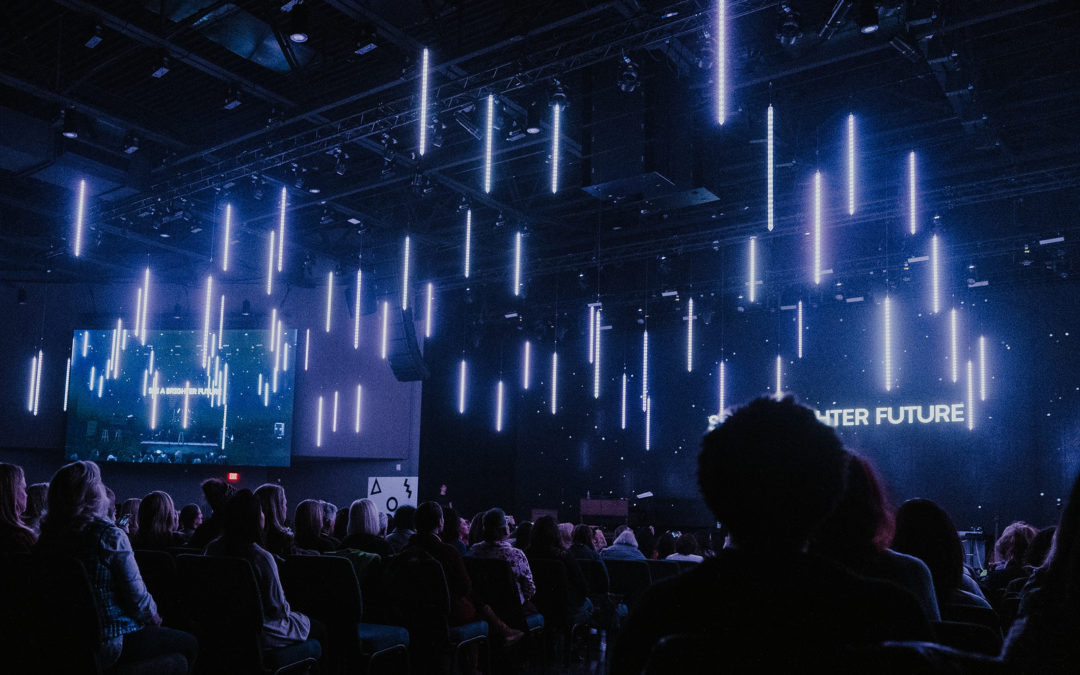Hello, and welcome to the Mod Scenes podcast. This is your host, Steven, I’m thrilled to chat with you about stage backdrops and creating awesome stage backdrops for your next church stage design. Uh, I’m coming to you live from the noisiest car in the entire world. The, uh, the monsoons panel van, uh, it’s not actually a panel van, but we do carry panels on it. So thus it is a Monsignor panel van. Uh, the air conditioner is currently, uh, heating life. And so it is, uh, letting everyone know and a very loud fashion. So my apologies on the noise, but nonetheless, I want to jump into, uh, this stage backdrop design, uh, podcast and how I can, uh, uh, how I can hopefully share some wisdom with you about how to create the best, uh, church stage design, uh, with use of stage backdrops in. Awesome, just like that.
So, um, as you probably know, um, at Mod Scenes is we’ve made it really simple to make a stage backdrop, our panels bolt together really easily. Uh, they bolt together with, uh, nylon bolts and we nuts. Uh, you can also substitute metal wing, nuts and bolts age. You’re wanting to have a more riveted look. Uh, we use fire rated Coroplast for the actual panels, uh, and those keep it nice and, uh, uh, nice and clean, uh, and obviously safe since they’re fire rated. Uh, we also use fire rated connectors. Uh, they’re made of a thinner plastic. Um, those are, those are really easy to put together. You put them on the back of your panels, put your nylon bolt through your wing nut on the backside, and you tighten the two together. Um, but enough about that, uh, let’s talk about design and creating a good design for your space.
So one of the keys and designing for a church stage, uh, is to make sure that whenever you’re designing your stage backdrop, that it’s actually serving its purpose. Uh, so if that’s purpose is just to hide something ugly, that’s fine. Um, but a lot of times people just make a design, a full, huge wide stage backdrop, whereas you can get a lot more creativity and actually save quite a bit of money if you go through and, uh, are a little bit more selective with where you place panels. So for example, instead of doing a big wide, um, a big wide stage backdrops, you could do a smaller than a set of strips, which will save you probably half as much. Uh, so
That’s a, uh, that’s, uh, an option creating something really cool. Uh, it’ll save you a little bit of time, uh, quite a bit of time and quite a bit of money as well. Actually,
Another option for creating a really nice stage backdrop. That’s going to be really creative and isn’t going to have, uh, as huge of a impact on your budget, uh, is to, um, space out the panels within a space. Uh, James Tucker, uh, the amazing James Tucker out of Jacksonville, Florida, who runs a company called Neato lights, which is super awesome that you should check out. Uh, he actually made a really great set with some of our panels. He put them, uh, rotated them on a 45 degree angle and then hung them about every like a two foot space between everyone. And it made a really beautiful look. Uh, it took a little bit more hardware. He ended up using like one buys and screws to hold them onto the, onto there. Um, but it looked incredible. It was actually one of my favorite uses of the samurai I’ve seen.
So, um, but you can use any of the panels like that kind of space them randomly. We’ve had other people, um, use like a fishing line and hang them randomly, like just on a flat plane. I’ve had other people who remove panels from like a strip, so do a strip, but remove like the seventh and the third and the eighth panels, so that you kind of get this like checkerboard thing. Um, Brent and the team, Brent Allen, and then team over at, uh, Northland church out in Longwood, Florida did a set like that, their stage backdrop, they created like, uh, that process looked incredible. Uh, they used it in their kids’ church and it was a really great, uh, set design. Uh, they were using the, uh, the Crescent moon panel, uh, whenever they were making that stage backdrop. Um, so yeah, and it was a really great, uh, designed for their, uh, stage of their church.
Um, so other options you can use is you can use our tower connectors, which will save you, uh, save you some, if you, depending on how you use them, because I would suggest to use them or as a, uh, attached or dimensional element than necessarily that the tower, because you can work those into a flat design, but a few of those connectors yeah. And, and really get a, a much larger impact, uh, with what you’re creating. Right. Uh, so yeah, so I hope this has been a helpful podcast, honestly, some of the, uh, some of the ways that you can, um, and, you know, stretch your budget and create some really great stage backdrops designs, uh, by using some, uh, unique new ways of laying out your panels. Uh, I’m really excited. We have some new products coming out relatively soon that I think you’re going to be great for serving churches and creating a really great designs with.
So I would love to chat with you about, um, our stage designed products and stage backdrops, um, about how we can customize things for you, uh, or about our DMX voice, which are really incredible. Um, some people would call them DMX winches, or kinetic kinetic lights. Um, they’re really awesome. If you haven’t seen, uh, had a chance to search for them in search, uh, either kinetic lights on YouTube, uh, kinetic lights, mod scenes on YouTube, or you can search, um, mod scenes, DMX voice on YouTube, um, or on the internet, you’ll find it, it pops up right near the top. So, uh, yeah. Yeah. So I’m really thrilled to serve you. Uh, again, feel free to reach out to me, stephen@modsceness.com and I’m looking forward to serving you soon.


Recent Comments